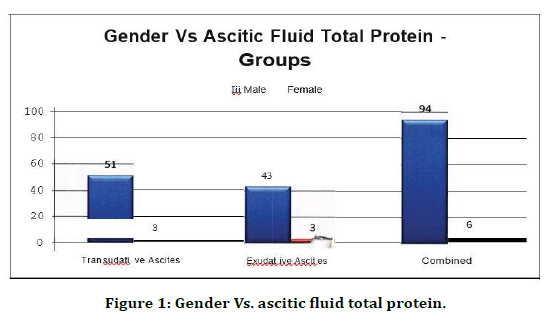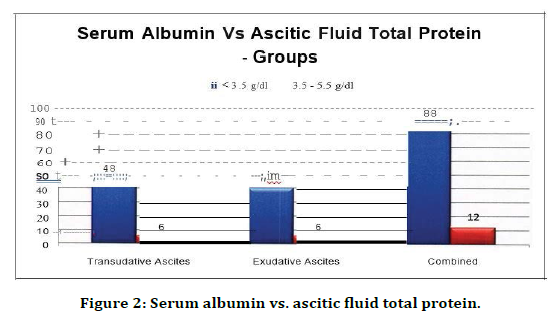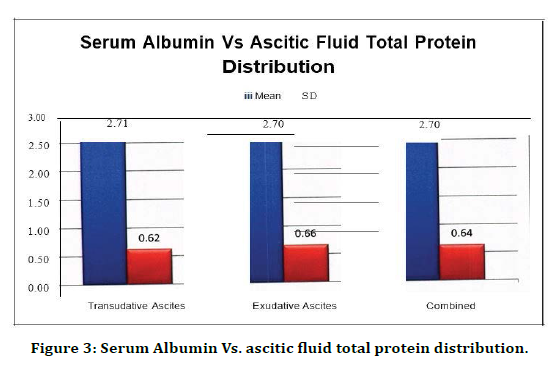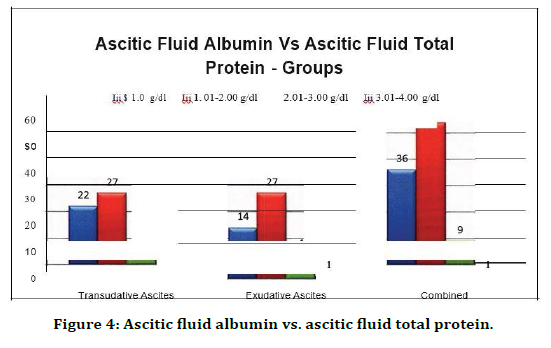Research - (2021) Volume 9, Issue 5
Comparison of the Diagnostic Accuracy of Serum Ascites Albumin Gradients (SAAG) With the Traditional Marker-Ascitic Fluid Total Protein
Aravindan R and KH Noorul Ameen*
*Correspondence: KH Noorul Ameen, Department of General Medicine, Sree Balaji Medical College and Hospital Affiliated to Bharath Institute of Higher Education and Research, India, Email:
Abstract
To determine the sensitivity and specificity of serum ascites albumin gradient (SAAG) and that of ascitic fluid total protein, in identifying the etiology of ascites. To compare the diagnostic accuracy of serum ascites albumin. A total of 100 adult patients with ascites, admitted to the Department of General Medicine, Sree Balaji medical college & hospital, Chennai within approved period, whose etiological diagnosis had not been known previously were studied prospectively. The protocol was approved by the hospital's ethical committee and an informed consent was obtained from all patients. On entry, a detailed history and clinical examination were conducted. The 100 patients who satisfied the set criteria were included in the study. The sensitivity and specificity of SAAG in the differentiation of different types of ascites are 94% and 91% respectively. The accuracy of SAAG in the etiological diagnosis 1s 94%. The serum ascites albumin gradient (SAAG) 1s superior to ascitic fluid total protein (AFTP) in the differential diagnosis of ascites and it 1s statistically significant.
Keywords
Failure, Ephrotic syndrome, peritoneal tuberculosis, Disseminated carcinomatosis, Pancreatitis, Myxedema.
Introduction
Ascites is defined as an accumulation of fluid within the peritoneal cavity. It complicates a variety of disorders [1] which include cirrhosis, decompensated heart failure, Ephrotic syndrome, peritoneal tuberculosis, disseminated carcinomatosis, pancreatitis, myxedema etc. In these conditions, ascites develops only because of the underlying illness. So, the evaluation of the patients with ascites requires, so that the cause of ascites could be established. A proper diagnosis is an important tool for the successful management of these patients. Diagnostic ascitic fluid aspiration 1s the most rapid and cost-effective test for identifying the basic disease process [2]. Previously the ascitic fluid total protein [AFTP] concentration was used to classify ascites as either exudative [AFT P>/=2.5 g/d l] or transudative [AFTP<2.5g /dl] [3]. This classification 1s unable to correctly identify the etiological factors responsible for the ascites. Hence this antiquated system of ascitic fluid is classified.
Giving false results and it offers only a little insight to the pathophysiology of the ascitic fluid formation. Further, these drawbacks led to the development of a new approach to classify as cites, based on the difference between the serum and ascitic fluid albumin concentration [Serum Ascites Albumin Gradient-SAAG]. A special technique was followed to prevent the leakage of fluid after the needle was withdrawn. This technique of needle insertion (Z tract) was accomplished by displacing the skin approximately 2 ems downward and then slowly inserting the paracentesis needle mounted on the syringe held. the other hand. The paracentesis needle is a steel 22-gauge needle about 1.5 inch in length. The hand holding the syringes was used to stabilize the syringes and to retract the plunger simultaneously. The skin was released only after the needle had penetrated the peritoneum. When the needle was ultimately removed, the skin resumed the original position and sealed the needle pathway. The needle was advanced slowly through the abdominal wall. Slow insertion helped to allow the bowel to move away from the needle thereby avoiding bowel puncture.
This newer concept classified ascites into two categories-High SAAG ascites with SAAG >/=1.1 g/dl in cases with portal hypertension and Low SAAG ascites with SAAG <1.1 g/dl in cases with ascites, unrelated to portal hypertensin [4-7]. The serum ascites albumin gradient [SAAG] has been proved in multiple studies to category. 1z e ascites better than either the ascitic fluid total protein or other parameters in ascitic fluid analysis. In view of the above, the present study is undertaken among the in patients, admitted with ascites in the medical wards of Sree Balaji medical college, to evaluate the value of SAAG in the etiological diagnosis of ascites and also to compare its sensitivity and diagnostic accuracy with that of ascitic fluid total protein [AFTP] [8- 11].
Materials and Methods
A total of 100 adult patients with ascites, admitted to the Department of General Medicine, Sree Balaji medical college & hospital, Chennai within approved period, whose etiological diagnosis had not been known previously were studied prospectively. The protocol was approved by the hospital's ethical committee and an informed consent was obtained from all patients. On entry, a detailed history and clinical examination were conducted. The 100 patients who satisfied the set criteria were included in the study. Paired ascitic fluid and serum samples were collected from them simultaneously and were examined for ascitic fluid albumin, ascitic fluid total protein and serum albumin with established methods of estimation.
Inclusion criteria
All patients with ascites due to any cause with normal coagulation profile.
Exclusion criteria
Ascitic patients with severe coagulopathy or disseminated intravascular coagulation (DIC).
Informed consent
Obtained.
Abdominal paracentesis
After obtaining informed consent from the patient and relatives, diagnostic abdominal paracentesis was done. The patients were asked to empty the bladder, prior to the procedure. The skin of the abdominal wall was disinfected with an iodine solution. The skin and subcutaneous tissue were infiltrated with a local anaesthetic. The needle was inserted into the left lower quadrant rather than the right lower quadrant because the caecum may be distended with gas from lactulose therapy. In the presence of a surgical scar, the needle was placed several centimeters from the scar. The ascitic fluid collected was sent for cell count in an EDTA bottle, biochemical an h1 sis including total protein and albumin in a plain bottle- and for cuture in a blood culture bottle. Simultaneously blood samples were collected from the patients and were sent for the estimation of serum albumin to the laboratory.
Calculation of SAAG
The serum ascites albumin gradient was calculated after measuring the serum and ascitic fluid albumin concentrations and simply subtracting the ascitic fluid value from the serum value. To increase the accuracy of SAAG, specimens of serum and ascitic fluid were obtained simultaneously.
Correction of SAAG
To correct the SAAG m the setting of a high serum globulin level the following formula was used. Corrected SAAG = Uncorrected SAAG x 0.16 x (Serum globulin ± 2.5). Serum hyperglobulinemia (Serum globulin >5 g/dl) leads to a high ascitic fluid globulin concentration and can narrow the albumin gradient by contributing to the oncotic forces. A narrow gradient caused by high globulin levels occurs in one percent of ascitic fluid specimens.
Albumin estimation
BCG method and protein in biuret method.
Results and Discussion
Majority of the patients belonged to the 31- 50 years age class intervals (n=29, 53.70%) in 70 years age class intervals (n=21, 45.65%) in exudative group. Among the study patients, there was no statistically significant difference 1n relation to age distribution between transudative group (mean=50.19, SD=l 1.25) and exudative group (mean=52 .89 , SD= l 2.88) with a p value of >0.05 as per unpaired t test. Therefore, we fail to reject the null hypothesis that there is no difference in age distribution between the study groups (Table 1 and Table 2) [12].
| Groups | Definition of Subjects | Number |
|---|---|---|
| Transudative Ascites | Ascitic Fluid Total Pro te in < 2.5g /dl | 54 |
| Exudative Ascites | Ascitic Fluid Total Protein 2: 2.5 g/dl | 46 |
Table 1: Groups.
| Null Hypothesis : HO | Transudative group equal in effect compared to Exudative group |
| Alternate Hypothesis :Hl | Exudative gr01 ha za rd ous in effect.., compared to Transudative group |
Table 2: Null hypothesis.
Majority of the patients belonged to male gender both in transudative group (n=51, 94.44%) and exudative group (n=43, 93.48%). Among the study pat i ents, there was no statistically significant difference in relation to gender status between transudative group ancative group with a p value of >0.0 5 as per fisher’s exact test. Therefore, we fail to reject the null hypothesis that there is no difference between gender status between the study groups (Figure 1) [13].

Figure 1. Gender Vs. ascitic fluid total protein.
Majority of the patients belonged to the < 3.5 g/ dl serum albumin levels class intervals (n=48, 88.89%) in transudative group and <3.5 g/ dl serum albumin levels class intervals (n=40, 86.96%) in exudative group. Among the study patients, there was no statistically significant difference in relation to serum albumin levels distribution between transudative group (mean=2.71, SD=0.62) and exudative group (mean=2.70, SD=0.66) with a p value of >0.0 5 as per unpaired t test. Therefore, we fail to reject the null hypothesis that there is no difference in serum albumin levels distribution between the study groups (Figure 2 and Figure 3) [14].

Figure 2. Serum albumin vs. ascitic fluid total protein.

Figure 3. Serum Albumin Vs. ascitic fluid total protein distribution.
Majority of the patients belonged to the 1.01- 2.0 0 g/dl ascitic fluid albumin levels class intervals (n=27, 50.00%) in transudative group and 1.01-2.00 g/dl ascitic fluid albumin levels class intervals (n=27, 58.70%) 1n exudative group. Among the study patients, there was no statistically significant difference in relation to ascitic fluid albumin levels distribution between transudative group (mean=l.27, SD=0.58) and exudative group (mean=l.35, SD=0.66) with a p value of >0.05 as per unpaired t test. Therefore, we fail to reject the null hypothesis that there is no difference in ascitic fluid albumin levels distribution between the study groups. The percentage of the patients who had TB as diagnosis in transudative group was 0.00% (n=0) and exudative group was 4.35% (n=2). Among the study patients, there was no statistically significant difference in relation to TB as diagnosis between transudative group and exudative group with a p value of >0.0 5 as per fisher’s exact test. Therefore, we fail to reject the null hypothesis that there is no difference in TB as diagnosis between the study groups (Figure 4) [15-18].

Figure 4. Ascitic fluid albumin vs. ascitic fluid total protein.
Conclusion
The study "Serum ascites albumin gradient in the etiological diagnosis of as cites" conducted among the hundred in-patients with ascites, in the wards of the Department of General Medicine, at Sree Balaji Medical College Hospital has concluded that. The sensitivity and specificity of SAAG in the differentiation of different types of ascites are 94% and 91% respectively. The accuracy of SAAG in the etiological diagnosis 1s 94%. The serum ascites albumin gradient (SAAG) 1s superior to ascitic fluid total protein (AFTP) in the differential diagnosis of ascites and it 1s statistically significant.
Funding
No funding sources.
Ethical Approval
The study was approved by the Institutional Ethics Committee
Conflict of Interest
The authors declare no conflict of interest.
Acknowledgments
The encouragement and support from Bharath University, Chennai, is gratefully acknowledged. For provided the laboratory facilities to carry out the research work.
References
- Sleisenger and Fordtran 's Gastrointestinal and Liver d ise as e, Pat hophys i ology/ Diag no sis /Mana ge me nt 8th edition- Mark Fel d man , Lawrence S. Frie d ma n, Lawreence J. Brandt et al.
- Ascites: e Medicine Gastroenterology Authors- Rahil Shah et al., Janlos M. Fields et al.
- Malignant ascites management - Relieving symptoms and improving quality of life Amy Pickar Abernethy et al., Symposium, American Society of Annual Meeting, Clinical Oncology.
- A companson of paracentesis and transjugular intrahepatic portosystemic shunting in patients with as ci tes , Rossle M. et al., Ochs A et al. , Gulberg V. et al.,N. Eng. J Med 2000; 342 ; 1701-7
- Indian Journal Pediatrics 2006; 73 (9): 819-824- Ascites in childhood liver disease - Surendar Kumar Yaccha et al. & Vikrant Khanna et al.
- Pat ho phys i ology of ascites formation, Dudley FJ et al., Gastroenterol. Clin North Am 1992; 21;215 - 235
- Management of Cirrhosis and A ites , Gines P et a l. , Cardenas et al., Arroya V et al., Rodes J et al., N Eng J Med 2004; 350: 1646 - 1654.
- Clinical and laboratory differentiation of cirrhosis and extrahepatic portal venous obstruction in chi l d re n, Peter L. Dadhich SK et al. , Yaccha SK et al. , J GastroenterolHepatol 2003; 18; 185-189.
- Oedema and ascites Hepat ol ogy, Principles and Practice - Kuntz E & Kuntz HT et al., Springer- Verlag Berlin , Heidelberg 2002; 266- 290.
- Dia gnosis, treatment and Prophylaxis of spontaneous bacterial peritonitis: a consensus document. J .Hepatol 2000; 32 : 142-153, Rimola A et al., Garcia Tsaog et al. , Navasa M et al.
- Mc Hutchison JG, et a l. , Differential diagnosis of ascites. Semin Liver Dis 1997; 17(3); 191-202.
- Maurer K et al., Manzione NC et al. , Usefulness of serum ascites albumin difference m separating transudative from exudative
- Albillos A et al., Curevas Mons V et al., Millan L et al. Ascitic fluid polymorphonuclear cell count and serum to ascites album in gradient in the diagnosis of bacterial peritonitis. Gastroenterol 1990; 98: 134-140.
- Arroyo V. et al., Gines P et a l. , 1992, Arterial vasodilatation and the pathogenesis of the hyperdynamic circulation and re_r. al sodium and water retention in cirrhosi. Gastroenterology 100 (1077-78).
- L ip sky MS et al. , Sternbach MR et al.: Evaluation and initial management of patients with ascites.
- Pinto PC et al., Large volume paracentesis m non ed ematous patients with tense ascites. Its effects on intravascular volume , Hepat olgy.
- The val id ity of the proteins concentrations m the ascitic liquid and serum for the differential diagnosis of the as cit es ,[Art ic l e in Spanish], Valdivia RM et al., Ll ano s C A et al. , Zapata S C et Munoz O N et al.
- Portal venous pressure and the serum-ascites albumin concentration gradient. Harjai KJ et al., Kamble MS et al. , Ashar VJ et al., Anklesaria PS et al. , Ratnam KL et al., Abraham P et al.
Author Info
Aravindan R and KH Noorul Ameen*
Department of General Medicine, Sree Balaji Medical College and Hospital Affiliated to Bharath Institute of Higher Education and Research, Chennai, Tamil Nadu, IndiaCitation: Aravindan R, KH Noorul Ameen, Comparison of the Diagnostic Accuracy of Serum Ascites Albumin Gradients (SAAG) With the Traditional Marker-Ascitic Fluid Total Protein, J Res Med Dent Sci, 2021, 9 (5):271-275.
Received: 24-Apr-2021 Accepted: 24-May-2021
